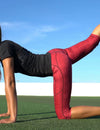
A new antioxidant supplement used by people with inflammatory conditions such as gout and arthritis, has been “hijacked” by athletes. Initial trials of the cherry juice concentrate with London Irish RFC were so impressive that it has now become a secret ingredient behind the success of several Premiership and International Rugby Teams (Wasps, Scotland RFU etc.), Premier Football teams (based in London and Manchester), the all-conquering British Cycling squad, the Lawn Tennis Association, top Mix Martial Arts and many international athletes.
If that sounds like the usual marketing hype – bear with us. We thought so too until right before publication of this issue, when John Carey, director of CherryActive, got a just-in-time email from sports scientists at London South bank University, with the results of tests on the supplement.
The results confirmed that supplementation during intense training gives significant improvement in recovery rates and less muscle soreness.
The report included this little teaser: “Despite this the extent of muscle damage as indicated by serum creatine kinase activity was similar between trials. This suggests that although the supplement speeds functional recovery, the extent of muscle damage which may underlie chronic training adaptations, is not compromised.”
What this appears to be saying is that while CherryActive tones down post-exercise inflammation and speeds recovery, it does not interfere with the inflammation needed to repair and regenerate muscle.
If true, this is a very important benefit since we all have concerns that athletes popping too many antioxidant supplements can actually interfere with the post-training, post-competition healing process.
I asked Dr Jo Bowtell, Head of research, Academy of Sport, London South Bank University, to confirm the findings. She told us: “The main conclusion is that CherryActive sped up recovery from intensive exercise without compromising the extent of muscle damaged caused.”
Explaining the research, she said: “Our data shows that when consuming CherryActive the participants recovered their functional capacity more quickly after the eccentric exercise than when they consumes the placebo. This was evidenced by the quicker recovery of the maximum voluntary contraction force (maximum isometric strength), tendency for higher eccentric power generated during the submaximal warm-up exercise and differences between trials in the EMG data.
The participants also tended to report less muscle soreness. We were anticipating that this would be the case, but my gut feeling beforehand was that this may be because CherryActive would limit muscle damage and reduce the inflammatory response, hence improving acute recovery. However, this could be at the expense of possibly compromising long term adaptations to training, as muscle damage and inflammation appear to be involved in muscle adaptation in response to training.
“however, the percentage increase in serum creatine kinase after the eccentric exercise (which is a marker of muscle damage) was not different between the trials. This suggests that the CherryActive did not reduce the extent of muscle damage caused. We only took one measure of inflammation which was Serum C Reactive Protein and this was not significantly different between trials, nor did it increase in response to the exercise, so we have no direct evidence of CherryActive reducing inflammation but this may relate to the marker used and also the population studied (well-trained and generally very low baseline serum CRP levels).”
Worth checking out? We think so. Nigel Mitchell, British Cycling Nutrition Advisor, has also gone on the record: “The British Cycling Endurance Squad riders took antioxidant-rich CherryActive concentrate as part of their preparations for the Olympic Games in Beijing. We believe that antioxidants play an important role in the performance and recovery of athletes and CherryActive is a valuable inclusion in our team’s nutrition strategy.”
Simon Martin, Editor Functional Sports (www.fsnjournal.com) - November 2009



